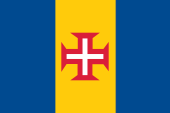|
|
| Übersicht – Contents: | |
Diese Seite ist Teil des Projektes
|
|
| Übersicht – Contents: | |
Flagge – Flag: |
|
 |
Flagge von Madeira – flag of Madeira, Seitenverhältnis – ratio = 2:3, Quelle/Source, nach/by: Wikipedia (EN)   |
| Die Flagge von Madeira zeigt drei senkrechte Streifen in den Farben Blau, Gelb und Blau mit einem roten (eigentlich rotbraunem) Tatzenkreuz in der Mitte (das Kreuz des Christusordens). Die Farbe Blau steht für das Meer und Gelb für das Festland. Blau und Gelb sind regional von großer Bedeutung, und auch die benachbarten, jedoch zu Spanien gehörenden Kanarischen Inseln verwenden ebenso Blau und Gelb in ihrer Flagge. Das Kreuz des Christusorden ist ein portugiesisches Symbol, welches im 17. Jahrhundert das offizielle Staatsemblem von Portugal war. Der portugiesische Christusorden ist unmittelbar aus dem Templerorden hervorgegangen, und hatte in Portugal quasi staatstragenden Charakter. Er initiierte die portugiesischen Entdeckungen und Eroberungen, so auch im Jahr 1419 die Inbesitznahme von Madeidra. | The flag
of Madeira shows three vertical stripes in the colours blue, yellow and blue
with a red (really auburn) paw-cross in the middle (the cross of the
Order of Christ). The color blue stands for the sea and yellow for the
mainland. Blue and yellow have a regional big significance, and even the neighbouring, however to Spain belonging Canary Islands use blue and yellow in its flag. The cross of the Order of Christ is a Portugese symbol, which was in the 17th century the official emblem of the state of Portugal. The Portugese Order of Christ has its roots directly in the Templar Order and had in Portugal quasi a state character. It advocates the Portugese discoveries and conquests, in this way as well the appropriation of Madeidra in the year 1419. |
| Quelle/Source: Flaggen Enzyklopädie, Flags of the World, Wikipedia (DE) | |
Landkarte – Map: |
|
| Zahlen und Fakten – Numbers and Facts: | |
|
|
|
|
|
|
|
|
|
|
|
|
|
|
|
|
|
| Antike ·
die unbewohnten Inseln sind den Griechen und Römern bekannt, geraten aber
später in Vergessenheit 1418 · die Inseln werden von den portugiesischen Seefahrern João Gonçalves und Tristão Vaz wiederentdeckt 1420 · erste portugiesische Besiedlung, Gründung der Stadt Funchal 1479–1482 · Christoph Kolumbus wohnt auf dem Archipel 1497 · Madeira wird offiziell dem Königreich Portugal angegliedert, Funchal wird Hauptstadt 1801–1807 · Besetzung durch britische Truppen, Einrichtung einer Flottenbasis für den Kampf gegen Napoléon 1976 · innere Autonomie |
| antiquity
· the uninhabited islands are well known the Greeks and Romans, but fell
later into oblivion 1418 · the islands become re-discovered by the Portugese seafarers João Gonçalves and Tristão Vaz 1420 · initial Portugese settlement, foundation of the town Funchal 1479–1482 · Christoph Columbus lives on the archipelago 1497 · Madeira becomes officially incorporated into the Kingdom of Portugal, Funchal becomes capital 1801–1807 · occupation by British troops, establishment of the fleet base for the struggle against Napoléon 1976 · interior autonomy |
| Quelle/Source: Wikipedia (D), Discovery '97 |
| Die Bezeichnung Madeira bedeutet "Holz". Die ersten Portugiesen gaben der Insel diesen Namen, als sie deren Holzreichtum sahen. | The denomination Madeira means "wood". The first Portugese used this name for the island as they saw its wood abundance. |
| Quelle/Source: Handbuch der geographischen Namen | |